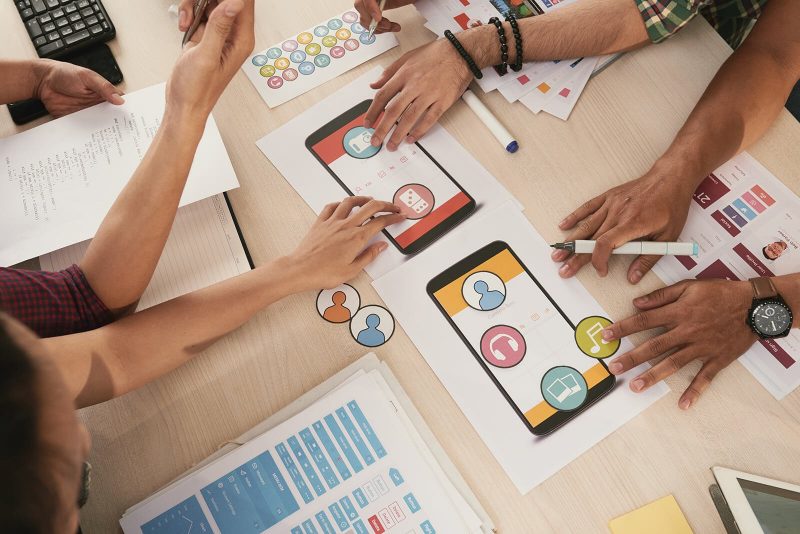In 2019, consumers have already downloaded 205 billion mobile apps. By 2022, we will have downloaded 258 applications. The demand in them is undeniable, that’s why a lot of businesses nowadays offer custom applications that allow easy communication with clients.
In this article, you’ll find out what it takes to develop a custom mobile application.
Mobile development lifecycle
We’ve segmented the whole mobile app cycle into 8 logically complete stages: market research and objectives, wireframing, thoughts on the backend, prototyping, development, testing, pre-launch, and launch.
Market research and app objectives
Surely, if you have a mindblowing idea and absolutely sure in it, miss this step and go further. But if not, it’s highly recommendable to start app dev process by answering the following questions:
- Who is our target audience?
- What problem will the app solve?
- What set of functions will it have?
- Are there any competitors on the market?
- What advantage does our app have over the competitors?
And more specific ones:
- What is our budget?
- How long are we going to develop the app?
- What platform(s) are we going to use?
- Which mobile app development language and framework are we going to use?
- What is your timeline for development? When will you launch your app?
- How are we going to promote the app?
Wireframing
At this stage, you should define the UI and UX of the application. You will find if it’s possible to transform your idea into a set of functions. And (spoiler) some of them will be redundant. That’s perfectly fine. It’s better to focus on fewer features but present them impeccably. You should also create a storyboard, or roadmap, to demonstrate a user flow from one screen to another.
Thoughts on backend
Most mobile apps need a backend service for things that can’t be done solely on a device, for example sharing and processing data from multiple users and storing large files. Core backend architecture is based on the application server, web server, and the database. The most popular technologies used in the backend include Ruby on Rails, Node.js, Django, PHP MVC frameworks and Google Firebase. Remember that, sometimes, you need to modify your wireframes and storyboard if you encounter technical limitations in the backend development process.
Prototyping
Backend and wireframes defined, it’s time to create an interactive prototype. At this stage, you will evaluate design concepts, gather feedback, and test the usability of your mobile app. It’s a good idea to let other people use the app, collect their feedback, and correct any flaws in the UI and UX.
Development
This phase includes a number of stages:
- The initial stage: only core functionality is developed but not tested.
- The second stage: much of the functionality proposed is incorporated. The app (ideally) has gone through light testing and bug fixing. The app is released to a closed group of external users for more testing.
- The third stage: the app moves to the deployment phase where it’s ready for release.
Testing
With testing, it’s never too early and too often if you want to keep your final costs low. Some of the testing has already been done at the development stage.
On the testing stage, you build various testing cases referring to the original design. The cases include usability, performance, stress, compatibility, security and interface checks. The final phase is called user acceptance testing: a group of people interacts with the app and gives their honest opinion on it. If the app has passed the acceptance test, it is available for a beta trial by a group from your target audience.
Pre-Launch
This is the time when your marketing team takes the lead. Their task is to make the app discoverable in Google search and App Store with the help of SEO (search engine optimization) and ASO (App Store Optimization).
You’ll also need to get high-quality screenshots of your app, concise and appealing app description and, maybe, even a promotional video or demo. To promote the application, you’ll need to create a website or at least a landing page. Here’s what your landing page should include:
- App name and icon
- Google Play and/or App Store badges
- Screenshots and a promo video
- Mailing list/subscription form for pre-launch, download links after launch
- Contact and customer support information
- Links to your social media accounts
- Testimonials and user reviews (after launch).
Launch
Remember that you have two options where to release your mobile application: App Store and Google Play. Keep in mind that for different application stores, the policies of launching an application are different. As your application is fully available to users, you’ll need to process the feedback. Loads of it. It’s important to answer EVERY SINGLE review in App Store and Google Play to improve your visibility. Also, your app will need updates and new features as soon as a new version of the app is released.
For the finale
Now, you have a clear picture of how the whole mobile development cycle works. It will help you plan your time and money budget on your next custom application, which, obviously, you can’t do without in 2019.





